This guide is intended to assist local agency maintenance workers in ensuring the effective maintenance of traffic signs. Traffic signs play a crucial role in communicating rules, warnings, guidance, and other information to drivers, facilitating safe and efficient navigation of roads and streets. Properly maintained signs are essential for enabling drivers to make informed decisions.
While this guide does not provide a comprehensive design manual for roadway signing, it directs readers to relevant resources such as the Manual on Uniform Traffic Control Devices (MUTCD), the Standard Highway Signs Handbook, and other references for comprehensive standards and guidance on all types of signs.
The guide covers various aspects of sign maintenance, including principles and types of traffic signs, materials used in their production, types of supports for installation, installation techniques, the importance of implementing a management system, inventory management, inspection procedures, preventive maintenance practices, repair and replacement guidelines, and the significance of recordkeeping.
Additionally, the guide includes appendices that offer supplementary information, such as details about materials and equipment used for sign maintenance, a description of clear zones, and typical work zone traffic control plans for sign maintenance activities.
Technical Documentation Page
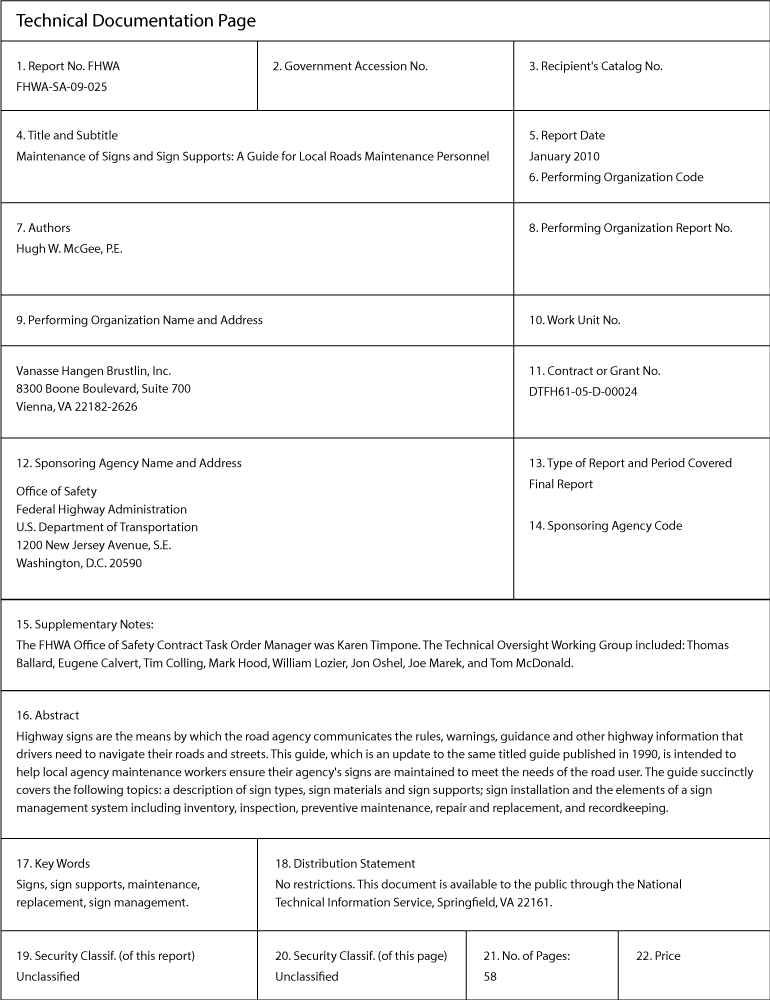
Acknowledgements
(Creater)
FUNDAMENTAL PRINCIPLES OF TRAFFIC SIGNS:
When it comes to the effectiveness of traffic signs, there are several key principles that need to be considered. While a comprehensive understanding of sign design, placement, operation, and maintenance can be found in resources like "The Traffic Signing Handbook," there are five fundamental requirements outlined in the Manual on Uniform Traffic Control Devices (MUTCD):
Fulfill a need
Traffic signs should serve a specific purpose and address a particular need. It is important to question the necessity of every sign during maintenance operations and ensure that it meets the relevant standards for its intended use.
Command attention
Signs should be designed and placed in a way that captures the attention of road users. This can be achieved through factors such as size, color, and placement to ensure that the signs are noticeable and effectively communicate their message.
Convey a clear simple meaning
The message conveyed by a traffic sign should be easily understandable to all road users. Clarity and simplicity in the design and wording of signs are crucial to ensure that the intended meaning is effectively communicated.
Command respect from road users
Signs should be authoritative and command respect from drivers and other road users. This can be achieved through the use of standardized symbols, colors, and formats that are widely recognized and understood.
Give adequate time for proper response
Road users need sufficient time to read and comprehend the information conveyed by signs, as well as to react accordingly. Proper placement and spacing of signs, combined with appropriate speed limits, allow drivers to adequately process the information and respond in a timely manner.
During the maintenance process, it is essential for staff to critically evaluate each sign they work on to ensure its necessity and compliance with applicable standards. The decision to install a sign should be based on engineering studies or the application of engineering judgment. If local jurisdictions lack engineering expertise in this regard, they should seek assistance from their State transportation agency, other jurisdictions, traffic engineering consultants, or utilize resources like the Local Technical Assistance Program (LTAP) available in each State and tribal area.
CLASSIFICATION AND TYPES OF TRAFFIC SIGNS
The MUTCD (Manual on Uniform Traffic Control Devices) categorizes signs into three main classes based on their purpose:
Regulatory signs:
These signs provide specific instructions and regulations that must be followed by road users. They inform drivers about traffic laws, restrictions, and prohibitions. Regulatory signs typically use words, symbols, or a combination of both to convey their message. They help maintain order and safety on the roads by enforcing rules such as speed limits, stop signs, yield signs, and parking regulations.
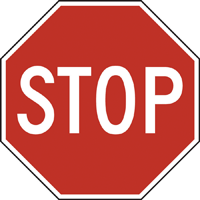
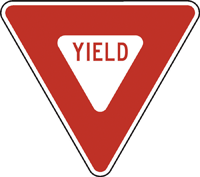
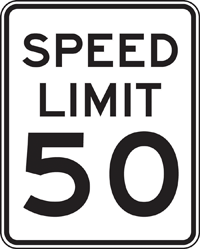
Red is commonly used on regulatory signs to indicate prohibitions or commands that drivers must follow. Examples include stop signs, yield signs, and do not enter signs.
White is used to display regulatory signs that provide general instructions or regulations, such as speed limits, parking regulations, or lane usage.
Black is often used for the text or symbols on regulatory signs to provide specific information or details.
It's important to note that the specific colors and their meanings may vary slightly depending on the jurisdiction, as there may be some local variations or adaptations to the MUTCD standards
Warning signs:
These signs are designed to alert drivers about potential hazards or conditions on the road ahead. They typically feature yellow or fluorescent yellow-green backgrounds with black symbols or text. Warning signs help drivers anticipate and prepare for upcoming dangers, such as sharp curves, slippery roads, pedestrian crossings, animal crossings, or construction zones. They play a crucial role in promoting awareness and reducing the risk of accidents.
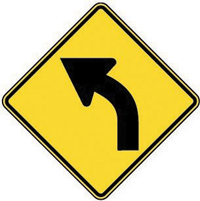
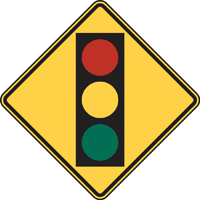
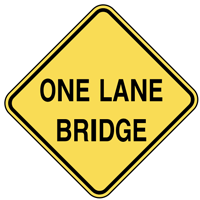
Guide signs:
These signs provide information and guidance to drivers, helping them navigate and reach their desired destinations. Guide signs use a combination of words, symbols, and arrows to convey directions, distances, and locations. They include signs for highways, street names, exits, destinations, services (e.g., gas stations, hospitals, rest areas), and tourist attractions. Guide signs are essential for promoting efficient and safe travel by providing clear and consistent information to drivers.


Green:
Green is the primary color used for most guide signs. It is used to indicate directional guidance and provide information about destinations, highway exits, and routes. Green guide signs are commonly seen on highways, expressways, and major roads.
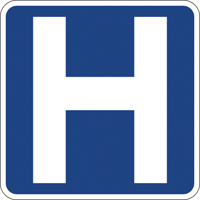
Blue:
Blue is used for guide signs that provide traveler services and amenities information. These signs may indicate services such as gas stations, rest areas, hospitals, food options, and lodging. Blue guide signs are intended to assist drivers in locating essential facilities and services during their journey.

Brown:
Brown is used for guide signs that highlight recreational and cultural interest areas. These signs typically point to national parks, historic sites, scenic routes, and other tourist attractions. Brown guide signs help drivers identify and navigate to points of interest and encourage tourism and exploration.
In summary, the MUTCD classifies signs into three categories based on their function: regulatory signs for enforcing traffic laws, warning signs for alerting drivers about potential hazards, and guide signs for providing information and directions to ensure smooth navigation.
EFFECTIVE SIGNAGE FOR WORK ZONES: PROMOTING SAFETY:
Work zone signs typically use specific colors to ensure visibility and communicate the presence of construction or maintenance activities on the road. The colors used for work zone signs are as follows:
Orange: Orange is the predominant color used for work zone signs. It is chosen because it stands out prominently and catches the attention of drivers, especially in high-traffic areas. Orange is associated with caution and alerts drivers to the presence of construction, maintenance, or other temporary activities on the road.
It's important to note that work zone signs may also incorporate other colors, such as yellow or fluorescent yellow-green, to enhance visibility and attract attention, especially in low-light conditions or when there is reduced visibility due to weather conditions. These color variations are often used for temporary signs, barricades, or delineators within work zones to ensure that drivers are aware of the changing road conditions.

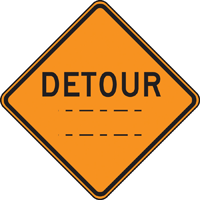
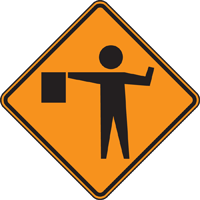
This section presents an introduction to the materials used for the sign face and the sign backing, facilitating a better understanding of their characteristics.
Road signs typically use retroreflective sheeting to enhance their visibility, especially during nighttime or low-light conditions. Retroreflective sheeting is designed to reflect light back to its source, such as the headlights of vehicles, making the sign more visible to drivers. There are different types of retroreflective sheeting used for road signs, including:
Engineering Grade (EG):
Engineering Grade retroreflective sheeting is the lowest level of retroreflectivity used for road signs. It consists of glass beads embedded in a transparent film or adhesive layer. EG sheeting provides moderate reflectivity and is commonly used for non-critical signs in low-speed areas.
High-Intensity Prismatic (HIP):
High-Intensity Prismatic retroreflective sheeting offers higher levels of reflectivity compared to EG sheeting. It is composed of retroreflective microprisms that are sealed onto a durable, weather-resistant backing. HIP sheeting is used for a wide range of road signs, including regulatory, warning, and guide signs, providing enhanced visibility in both daytime and nighttime conditions.
Diamond Grade (DG):
Diamond Grade retroreflective sheeting offers the highest level of reflectivity. It uses a combination of microprismatic technology and a prismatic lens design to provide superior visibility. DG sheeting is typically used for signs in areas with higher traffic volumes, complex intersections, or challenging visibility conditions.
The specific type of retroreflective sheeting used for road signs is often determined by local regulations and the specific requirements of the road authority responsible for sign installation and maintenance.

Retroreflective sheeting materials used for road signs are often categorized into different classes or levels based on their reflectivity and performance. The numerical classification system typically varies depending on the country or region. Here are some commonly used numerical classifications for retroreflective sheeting based on their performance levels:
Type I
often known as engineering grade, is typically produced using enclosed lens glass beads sheeting.
Type II
also known as super-engineering grade, is typically made of glass beads.
Type III
commonly referred to as high intensity, can be manufactured using encapsulated glass beads or microprisms.
Types IV, VIII, IX, and XI
do not have specific common identifiers, but they are referred to as prismatic materials, with variations in the angles of the microprism being the distinguishing factor.
Table 1: Minimum coefficient of retroreflectivity ra for several types of new sheeting used for Rigid Signs
Coefficient of Retroreflectivity for 0.2 deg Observation and -4 deg Entrance Angles
(TABLE 1 (ASTM Standard Specification D4956=09
It's important to note that the specific numerical classifications and their corresponding reflectivity levels may vary depending on the country or region's standards and regulations. Road authorities and transportation agencies often specify the required retroreflectivity class or level for road signs based on the specific roadway conditions and safety considerations in their jurisdiction.
(IMAGE)
White to red contrast ratio shall be at least 3:1
Source:modified from MUTCD 2009
Utilizing the information provided in Table 2, it is recommended to avoid using Type I sheeting material for warning signs and the white legend on green background guide signs. This is due to its inability to meet the required retro reflectance level necessary for driver visibility. Opting for higher-level sheeting types will result in brighter signs and generally longer service life, leading to cost savings in the long run.
According to the 2009 MUTCD (Manual on Uniform Traffic Control Devices), agencies are required to establish and implement a sign assessment or management method by January 2012 to ensure compliance with minimum retroreflectivity levels. The deadline for replacing signs that fail to meet these requirements is January 2015, with the exception of street name signs, which must be replaced by January 2018.
For more information on sign materials, particularly sign retroreflectivity, you can visit the FHWA (Federal Highway Administration) website at www.highways.dot.gov/safety/.
SIGN BACKING:
The retroreflective sheeting material is affixed to the rigid sign backing, also referred to as the substrate. Common substrate options include aluminum, wood (such as plywood), or composite plastic. Among these, aluminum is the most prevalent choice due to its widespread usage. The advantage of aluminum backing is its reusability, which reduces signing costs, and it can be easily recycled, enabling a partial cost recovery.Plywood is occasionally utilized for temporary signs as it can be more cost-effective and lighter compared to aluminum. On the other hand, fiberglass-reinforced plastic materials are infrequently used due to challenges in handling and recycling.

Most agencies use aluminum for sign backing
The term "sign support" refers to the equipment utilized to present the traffic sign, comprising a vertical post and, if necessary, any additional stiffeners to which the sign panel is affixed
- Wood Post
- U-channel steel post
- Square or round tube steel post
- I-beam steel post
Wood Post:
Wood posts are commonly employed, particularly in areas where wood is a cost-effective alternative to metal supports. These posts are typically available in sizes ranging from 4 x 4 inches to 6 x 8 inches. It is crucial to note that any post larger than 4 x 4 inches in nominal size must be drilled perpendicular to the flow of traffic. This allows the post to break away if it is struck by a motor vehicle.
Smaller supports have an approximate cross-sectional area of 16 square inches. It is recommended to bury this type of post at a depth of around 30 to 36 inches, taking into account soil type and backfill material specifications outlined by the state or the Local Technical Assistance Program (LTAP). In some cases, deeper burial may be necessary to minimize vandalism and the risk of displacement due to strong winds. While one or two posts can be used to form the sign support, placing posts too closely together can impact their crashworthiness.
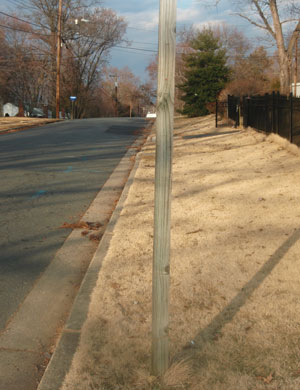
Small wood support is typically a 4 x4 inch post
To ensure breakaway capability, it is advisable to incorporate drilled large supports. For instance, a 6 x 8 inch wooden post can be utilized by creating two 3-inch holes that are drilled perpendicular to the roadway, effectively weakening the cross section. When it comes to undrilled wooden posts, a 4 x 4 inch size is the largest recommended for functioning as a breakaway support.
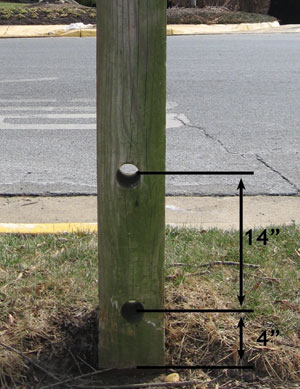
Holes are needed for wood posts greater than 4 x 4inches
U-Channel Steel Post:
The U-channel hot rolled steel post is a frequently used small sign support. It is designed to be breakaway, meaning that upon impact, it will bend, break, or detach from the ground.
When installing the post, it should be driven into the ground rather than being encased in concrete. This allows for easier removal in the event of damage or breakage. It is recommended not to drive or set the post into the ground more than 3.5 feet, as this ensures easier removal and replacement if necessary.
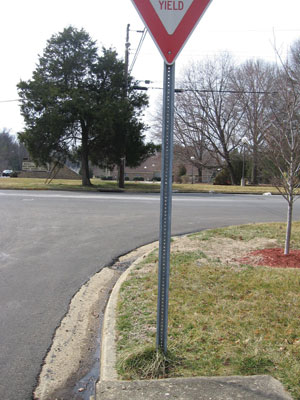
Typical U-channel Post
Breakaway devices are crucial for ensuring safety in the event of a collision with sign posts. A U-channel post made of re-rolled rail steel, weighing 3 pounds-per-foot or less, satisfies breakaway requirements on its own. However, if a heavier post is used, commercially available splices can be used to install them at ground level. Another option is to employ a stub post of the same material, set in a concrete base with a 4-inch length, which allows for bolting the sign post to the base connection.
These breakaway devices offer several advantages. Firstly, they enhance safety by minimizing the impact force and potential damage during a collision. Additionally, they simplify repairs and replacements, as damaged components can be easily removed and replaced. Moreover, the availability of breakaway devices enables the use of U-channel posts in concrete areas where it may be necessary.
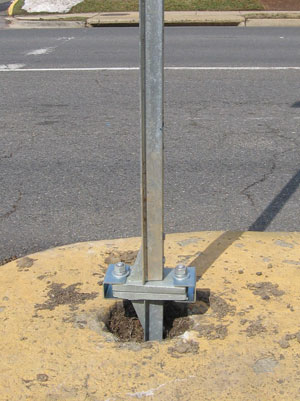

Breakaway treatments for U-channel posts
Square Steel tube:
The square steel tube (perforated) design is another commonly used sign post found in many localities. If these posts have a size of 2 ¼ inches or less, they are considered breakaway.
When installing this type of post, it should be driven into the ground without the use of concrete. Avoid placing concrete around the post. By not driving or setting the post more than three feet into the ground, a broken or damaged post becomes easier to remove. This approach facilitates efficient removal and replacement, if needed, in the future.
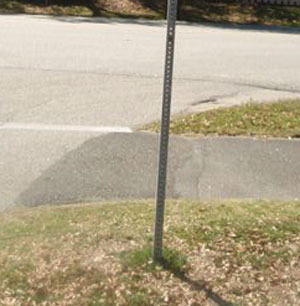
Typical square steel post
Similar to the U-channel post, sleeve assemblies can be employed as breakaway devices for the base of the sign. Alternatively, slip couplings can be utilized near the base. These devices serve to enhance the safety of the sign in the event of a collision and facilitate easier repairs.
In case of a collision, the broken stub of the post can be easily removed from the base sleeve, allowing for straightforward replacement with a new sign post. This streamlined process minimizes downtime and ensures efficient restoration of the sign.
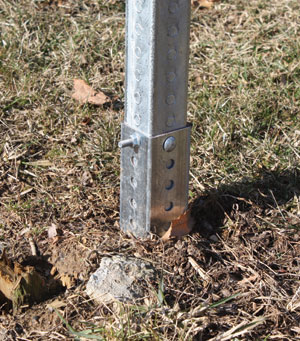
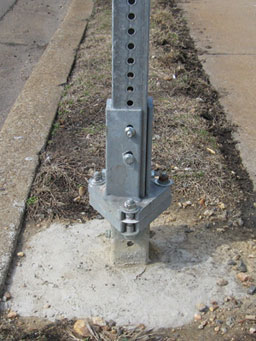
Two types of breakaway designs
I- Beam, Steel Post:
The post type is employed when there is a need to support large sign panels, which is frequently the case for roadside post-mounted guide signs.
For all large steel posts, a breakaway feature is incorporated, except when they are protected by barriers or positioned outside the clear zone. This is typically achieved through the utilization of a slip base that connects the post to the foundation. In the event of a collision, the post slips off the foundation at the bottom and rotates around the hinge plate situated below the sign panel. This design allows the vehicle to pass safely beneath the sign after impact, reducing the risk of severe consequences.

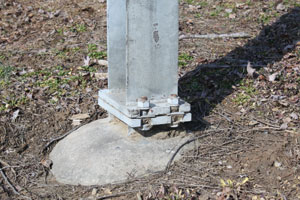
I-beam steel posts with slip bases are typically employed for larger roadside guide signs
In addition to the aforementioned types, there are numerous other commercially available products for sign supports. The specific choice of support depends on local requirements and cost considerations. This publication highlights four of the most commonly used small sign supports, but there is a wide range of options available.
For more comprehensive information on breakaway sign supports, it is recommended to refer to "A Guide to Small Sign Support Hardware," which provides detailed guidance in this regard.
Location and Height of Signs:
When installing a sign for the first time or replacing an existing sign, it is essential for the sign technician to be knowledgeable about the roadside positioning requirements. Sign placement involves considering the longitudinal position along the road, the lateral distance from the road's edge, and the vertical height above the ground. It is important not to assume that the original sign was correctly positioned when undertaking a replacement.
To ensure visibility and compliance with crashworthiness standards, the sign technician must verify the location of the support and the mounting height of the sign above the roadway. The specific requirements for sign placement vary depending on the sign type and the particular situation. It is recommended to consult the current edition of the MUTCD (Manual on Uniform Traffic Control Devices), your State standards and/or directives, as well as your agency's requirements for detailed guidance.
The figures provided on the next page offer recommended height and lateral location information in accordance with the MUTCD guidelines.
Before installing a new sign,IT IS CRUCIAL TO CONTACT THE UTILITY COMPANY AND ANY OTHER RELEVANT ENTITIES THAT MAY HAVE UNDERGROUND CABLES AND CONDUITS TO ENSURE SAFE INSTALLATION PROCEDURES
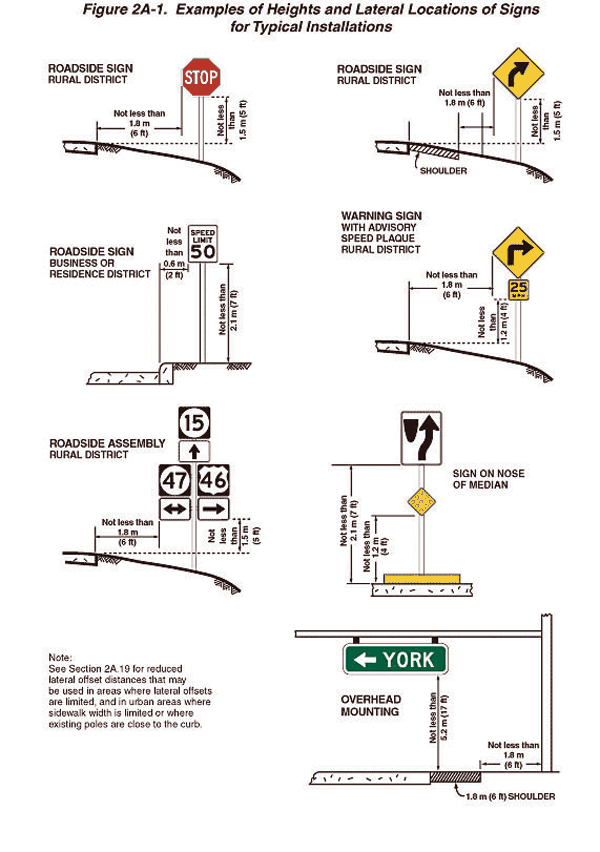
Source: MUTCD,2009
Positioning Signs:
Proper alignment of traffic signs is essential to achieve optimal retroreflection while minimizing specular glare, which refers to the mirror-like reflections on glossy surfaces. Specular glare can be particularly problematic, making sign legends unreadable, especially under intense sunlight conditions. This issue is often identified through driver complaints.
To prevent specular glare, it is recommended to position signs slightly more than perpendicular to the roadway. Sheet manufacturers suggest a recommended angle of 93 degrees. By angling the signs in this manner, the occurrence of specular glare can be minimized, ensuring better
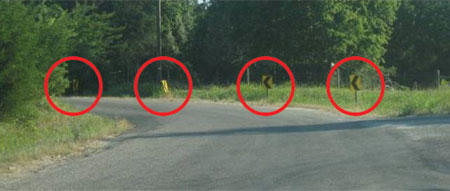
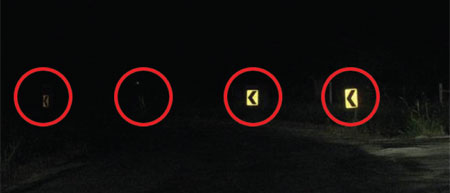
When signs are out of proper alignment, they will not be as visible at night
To accomplish the intended objective of ensuring high-quality sign maintenance, it is essential to establish and adhere to a comprehensive sign management system. This system encompasses various elements, including:
To achieve the desired goal of maintaining high-quality signs, it is crucial to establish and implement a comprehensive sign management system. This system comprises several key elements, which include:
Inventory:
This involves creating a manual or computer-based database that lists all the signs installed on the road network.
Inspection:
Implementing a scheduled inspection program to regularly assess the condition and effectiveness of the signs.
Preventive Maintenance:
Undertaking proactive measures to ensure that signs remain in optimal condition throughout their expected service life.
Repair and Replacement:
Developing a program and process for promptly repairing or replacing signs that are damaged, non-functional, or no longer meet the required standards.
Reporting and Record Keeping:
Establishing a systematic approach to documenting and maintaining records of all maintenance activities carried out on the signs.Each of these elements will be further discussed in separate chapters to provide detailed guidance and best practices.Having knowledge of the signs present on the road network enables the agency to establish a systematic sign maintenance program and determine the necessary resources to meet the desired level of maintenance outlined in the agency's sign maintenance policies. An inventory of signs serves multiple purposes:
Sign Life:
By recording the installation dates of signs, their age can be tracked, allowing the agency to assess when a sign has reached the end of its useful life. Regular nighttime inspections can further aid in determining signs that require replacement.
Management and Prioritization:
An inventory that includes sign locations and recent maintenance activities helps in identifying specific signs that need replacement, areas where sign improvements are necessary, and when vegetation needs to be cleared from signs.
Minimizing Tort Liability:
An inventory provides documentation of inspection and maintenance activities, which can be crucial in mitigating liability concerns.
Budgeting:
An inventory facilitates effective resource management for sign replacements, allowing for budget planning on an annual or as-needed basis.
Efficiency:
Integrating work orders with the inventory system enables monitoring of signing activities and facilitates scheduling of maintenance tasks.
Inventory systems can range from simple manual card systems to computer-based solutions. Nowadays, affordable or even free computer software packages are available, making computer-based inventories more efficient and user-friendly. Additionally, the use of GPS technology allows for accurate sign location and mapping on Geographic Information Systems (GIS). Computerized sign inventories can be obtained from sign vendors or Local Technical Assistance Programs (LTAPs). Examples of sign inventory systems can be found on the websites of Utah LTAPs_________
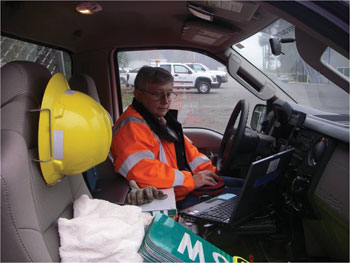
By utilizing a computerized sign inventory system, sign technicians can conveniently capture data while working in the field.
The success of an inventory program relies on the collection of relevant data elements and maintaining their accuracy over time. When establishing an inventory, it is important to consider the data elements listed in Table 3 as they provide essential information.
(Table 3: Data Elements for Sign Inventory)
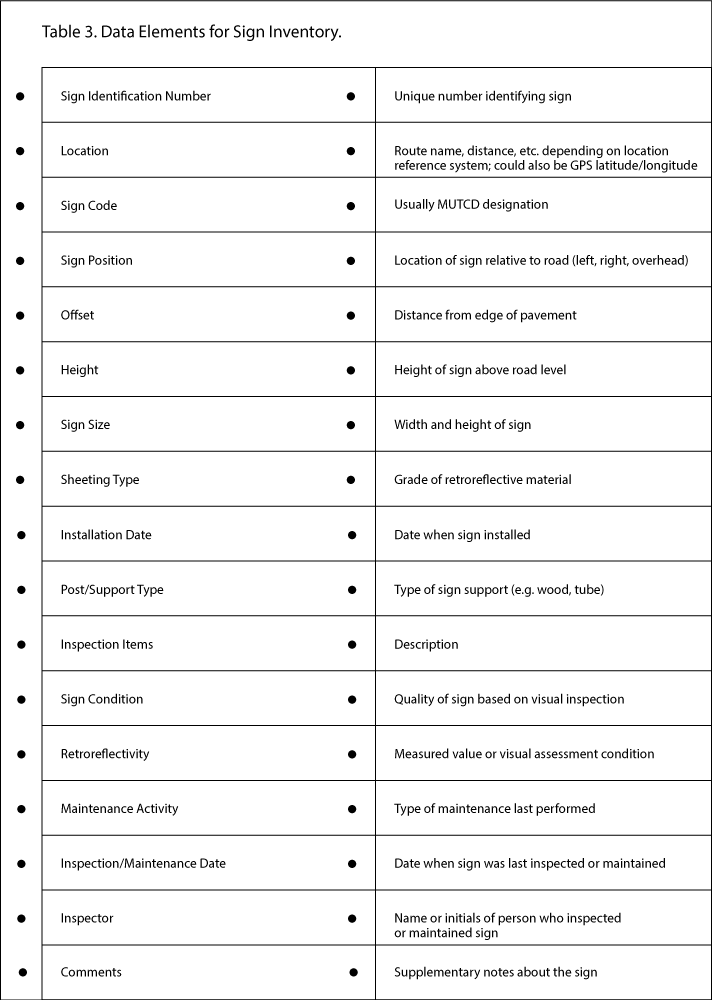

Sign dating labels with anti-vandalism warnings can be applied to the back of the sign
Prompt identification and response to maintenance needs are crucial components of an effective sign management system. This can be achieved through regular inspections to ensure signs are present, necessary, and functioning properly during both daytime and nighttime conditions.
Informal methods can also help identify defective signs, including:
- Agency's employees: Train all staff members to be vigilant for any signs that require attention and encourage them to report their observations.
- Police patrols: Establish a procedure for the police department to notify the agency of any sign-related issues they encounter during their patrols.
- Citizen inputs: Encourage citizens to contact the agency when they notice any sign problems by providing a phone number on the sign or sign dating sticker.
- Upon receiving notice of any sign deficiencies through the above methods, it is important to record and address them based on their priority level.
- In addition to informal detection methods, the agency's formal inspection program should include the following
- Training of sign technicians: Provide comprehensive training to maintenance staff on how to identify various sign deficiencies and what to look for during inspections.
- Inspection schedule: Establish a policy outlining the frequency of inspections, considering factors such as sign importance, road type, and traffic volumes.
- Inspection procedures: Define detailed procedures for conducting inspections, which should be prescribed by the agency and used for staff training purposes.
- On-the-spot repair/replacement: Equip maintenance technicians with necessary tools, replacement parts, and signs to address common deficiencies immediately.
- Proper documentation and record-keeping should accompany the maintenance activities to ensure accountability and facilitate future reference.